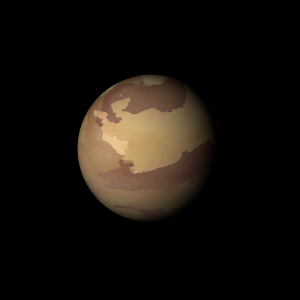|
|
Space Astro
|
Info for exoplanet "Hyrteadra"
| Scientific (actual) data |
|---|
| Name | KOI-7051 b |
| Planet status | Confirmed |
| Radius | 0.106 |
| Orbital period | 0.772807 |
| Semi major axis | 0.0143 |
| Inclination | 86.52 |
| Discovered | 2017 |
| Updated | 2022-06-10 |
| Tzero tr | 2454960 |
| Impact parameter | 0.2967 |
| Temperature (kelvin) | 1367 |
| Publication | Published in a refereed paper |
| Detection type | Primary Transit |
| Radius measurement type | Primary Transit |
| Star name | 2MASS J20052510+4431298 |
| Right ascension | 301.36° |
| Declination | 44.52° |
| Mag i | 15.433 |
| Mag j | 13.886 |
| Mag h | 13.313 |
| Mag k | 13.191 |
| Star metallicity | -0.16 |
| Star mass | 0.659 |
| Star radius | 0.668 |
| Star temperature | 4535 |
| Star alternate names | 8526387 |
| Wikipedia article | KOI-7051 b |
Back
| |
| Fictional info (?) |
|---|
| Suggested name | Hyrteadra |
| Planet type | Hot planet |
| It is a hot planet planet with a mass one-thousandth that of 2MASS J20052510+4431298, but two-and-a-half times that of all the other planets in its solar system combined.
Its north and south poles, therefore, lie where most other planets have their equators. |
| Atmosphere | Ethane | 54% |
| Nitrogen | 37% |
| 2H2O | 4.8% |
| Methane | 3% |
| Krypton | 0.28% |
| Helium | 0.00062% |
| Ozone | 5.1E-5% |
| Atmospheric pressure | 0.0021 bar |
 |
| No known satellites |
| Google search for Hyrteadra |
|
Website by Joachim Michaelis
|
|
|
|